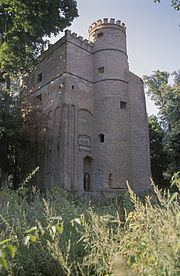Gmina Żmigród Elevation 150 m Population 6,573 (2006) | Postal code 55-140 Area 9.49 km² Local time Monday 2:34 AM | |
 | ||
Weather 9°C, Wind NW at 5 km/h, 85% Humidity Voivodeship | ||
Gutek migr d fontanna d
Żmigród [ˈʐmiɡrut] (German: Trachenberg) is a town in Trzebnica County, Lower Silesian Voivodeship, in south-western Poland. It is the seat of the administrative district (gmina) called Gmina Żmigród. Prior to 1945, it was part of Germany.
Contents
Map of %C5%BBmigr%C3%B3d, Poland
migr d
Geography
The town lies in the historic Lower Silesia region on the Barycz River, approximately 22 kilometres (14 mi) north-west of Trzebnica, and 40 kilometres (25 mi) north of the regional capital Wrocław. Its name is derived from Old Polish Żmij, "dragon" (German: Drachen) and gród, "castle" (German: Burg), displayed in the town's coat of arms.
As at 2006, the town has a population of 6,573.
History
The oldest sources say the settlement existed in the third period of the Bronze Age. The first records of a former Slavic settlement named Zunigrod (present-day Żmigródek) on the north bank of the Barycz River, then held by the Bishop of Wrocław, appear in the library of Pope Adrian IV in 1155. The current city on the other side of the river was invested according to German town law by one Tydricus dictus Deysenberc at the behest of the Piast duke Henry III the White in 1253, in a place where there was a ford. The castle near the border with Greater Poland was fortified, surrounded by a strong palisade, ramparts and a moat, there were built two gates, which were abolished only in 1819. The German name Trachinburg first appeared in 1287. From 1290 the town was part of the Silesian Duchy of Głogów, from 1312 part of the Duchy of Oels.
In 1492, Trachenberg was elevated to an autonomous state country of the Bohemian Crown. About 1555 the population turned Protestant. After a fire in 1579 a new castle with a tower was built and later upgraded under the rule of the House of Schaffgotsch, who had acquired the estates in 1592. During the Thirty Years' War, the owner Hans Ulrich von Schaffgotsch, a loyal supporter of the assassinated generalissimo Albrecht von Wallenstein was executed in 1635 and his estates seized by Emperor Ferdinand II. Trachenberg Castle was enfeoffed to the Imperial field marshal Count Melchior von Hatzfeldt in 1641. It was besieged several times and finally captured by the Swedish army under the command of General Lennart Torstensson in 1642. The Swedes occupied the castle until 1650. After the war, the area was subjected to stern Counter-Reformation measures. Another expansion of the castle took place in the years 1655-1657 on the initiative of Count Hatzfeld. In 1691, new fortifications were erected.
In the mid-seventeenth century, the Polish-German language boundary ran near Trachenberg, including the city, to the territory of Polish language dominance.
In 1813, in the baroque palace of the House of Hatzfeld, there was a meeting of the Prussian king Friedrich Wilhelm III of the Russian Tsar Alexander I, in which the Trachenberg Plan was agreed on, to avoid major battles in the struggle with Napoleon Bonaparte.
On January 23, 1945, the 10th Guards Tank Corps of the 4th Guards Tank Army commanded by General Dmitri Daniłowicz Leluszenki defeated the German garrison of Trachenberg and captured the town. The town was destroyed, except for the castle, which was set on fire after the battle. The city was annexed by Poland, and the native Germans were expelled to Germany.
Up until the Second World War, the town (then called Trach(t)enberg) had a significant Jewish population. Its former German name is the source of the common Jewish name "Trachtenberg".
